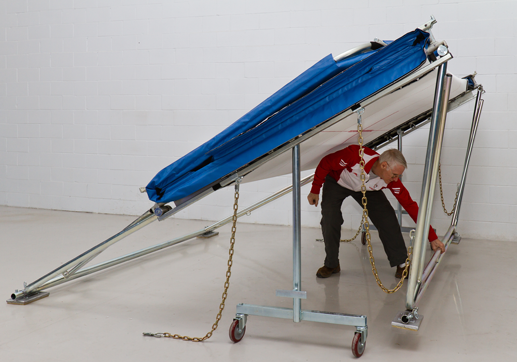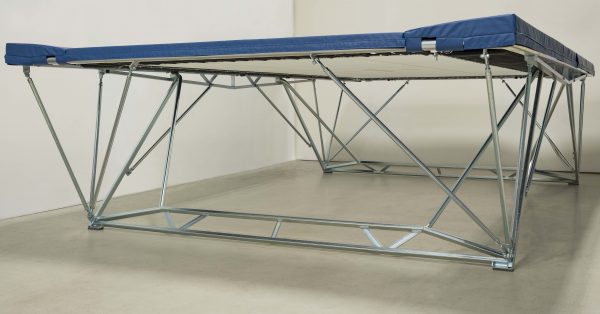More Articles...
Trampolines have come a long way since their invention in the 1930s. Today, we're spoiled for choice with various designs and features. Two main categories stand out: folding and non-folding trampolines. Each type has its strengths and weaknesses, making it suitable for different uses and environments. Let's look into the specifics and explore what Rebound Products offers in both categories.
The folding trampoline: a study in convenience
Picture this: You're a gymnastics coach who needs to set up and take down equipment frequently. Enter the folding trampoline. These clever devices are designed with portability in mind. They're quicker to set up and easier to move around, making them ideal for environments where space is at a premium or where the trampoline needs to be stored away regularly.
Rebound Products' folding trampolines shine in school gyms and multi-sport facilities. They can be tucked away in equipment cupboards when not in use, freeing up valuable floor space for other activities. This flexibility comes at a slightly higher cost, though. Folding trampolines typically cost about 1.5 times more than their non-folding counterparts.
But what about performance? You might think that the ability to fold would compromise bounce quality. Surprisingly, folding trampolines come close to matching the bounce of non-folding models. The difference is minimal enough that most users won't notice it during regular use.
Safety first: the folding frame conundrum
Now, you might be wondering about safety. It's a valid concern, given that the frame folds. While it's true that folding trampolines have slightly lower frame stability compared to non-folding ones, this isn't a major safety factor. The quality of the frame pads plays a more crucial role in ensuring user safety.

Rebound Products has addressed potential weak points in their folding trampolines. They've introduced frame clips, which significantly increase the frame's lifespan. These clips help maintain the integrity of the trampoline over time, even with frequent folding and unfolding.
The non-folding trampoline: strength and stability
Shifting gears, let's talk about non-folding trampolines. These are the workhorses of the trampoline world. They're sturdy, reliable, and less expensive than their folding cousins. Rebound Products' non-folding trampolines are particularly impressive, boasting tubing that's 40% larger than standard models. This extra heft translates to significantly increased strength.

The trade-off? Non-folding trampolines take up more space. For the same inner dimensions, you're looking at about 2 feet more in width and 2 inches more in length compared to a folding model. However, this extra space requirement comes with benefits. The wider a trampoline is, the smoother the bounce, assuming the same springs are used.
Athletes who've experienced Rebound Products' non-folding trampolines often prefer them due to their improved stability. There are no weak points at the hinges, and they include more bracing. This makes them about 40% stronger than folding trampolines.
Maintenance matters
Let's talk upkeep. Folding trampolines require more maintenance than non-folding ones. This is due to the additional moving parts and potential weak points that come with the folding mechanism. However, it's worth noting that the big maintenance items on any trampoline are the bed and springs, which wear with use over time regardless of whether the frame folds or not.
On the flip side, non-folding trampolines have a feature that saves time and effort. Due to their extra bracing, you don't need to pull out the legs every time someone lands on the end decks. This can be a real time-saver during intense training sessions.
Choosing the right trampoline for you
So, how do you decide between a folding and non-folding trampoline? It really boils down to your specific needs and circumstances.
If you need a trampoline that can be easily moved or stored, a folding model might be your best bet. They're great for demonstrations and gyms with multiple sports. They also come in handy if you plan to travel with your trampoline or relocate it frequently.
On the other hand, if you're setting up a permanent facility or looking for outdoor use, a non-folding trampoline is likely the better choice. You'll get a stronger frame at a lower price, which is hard to beat if you don't need the portability of a folding model.
For those interested in competitive trampolining, both folding and non-folding models are acceptable. Competition-sized trampolines have a 7' by 14' bed, and the choice between folding and non-folding isn't specified in the rules.
Safety features to look out for
Regardless of whether you choose a folding or non-folding trampoline, there are certain safety features you should prioritize. Look for thick frame pads that are well-secured. These pads protect users from accidentally hitting the metal frame or springs. Good end decks with quality end deck mats are also crucial for safe dismounts and landings.
The Rebound Products difference
Rebound Products has established itself as a leader in both folding and non-folding trampoline categories. Our folding trampolines use the Eurotramp frame, currently considered the best on the market for competition-sized folding trampolines. For non-folding models, Rebound Products has designed and built what many consider to be the best frame available.
One unique aspect of Rebound Products' offerings is our commitment to customization. We understand that different users have different needs. That's why we offer consultation services to help you choose the trampoline that's right for your specific situation.
Making your decision
Choosing between a folding and non-folding trampoline isn't always straightforward. You'll need to consider factors like available space, frequency of use, portability needs, and budget. Remember, while folding trampolines offer convenience, non-folding models provide superior strength and stability at a lower cost.
If you're still unsure which type would suit you best, don't hesitate to reach out to the team at Rebound Products. We’re more than happy to discuss your specific requirements and help you make an informed decision. You can contact us Toll Free at (877) 573-2686 or by phone at (905) 787-9090. Our email address is reboundproducts@gmail.com. We look forward to hearing from you!
In the world of trampolines, there's no one-size-fits-all solution. But with the right information and guidance, you can find the perfect trampoline to meet your needs, whether that's a space-saving folding model or a robust non-folding one. Happy bouncing!

